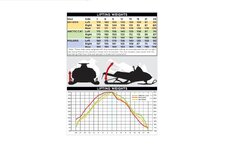L
I have a 2022 RMK Pro Matryx Slash 165 (all stock) and about midway through the season noticed that it lays over very easily to the clutch side but not so easy to the muffler side. I tried it while moving, from a standstill with a blip and just standing and pulling it over. I’ve done it on concrete and on snow. All the same.
The shocks up front are set to the same setting and the springs look like they are positioned the same on both sides. I tried pushing down on the front bumper but didn’t notice any softness to either side.
Before I ask my dealer to take a look at what I think is going to be a silly question is there anything I can do to diagnose myself? And ideas on what it might be?
Thanks in advance.
The shocks up front are set to the same setting and the springs look like they are positioned the same on both sides. I tried pushing down on the front bumper but didn’t notice any softness to either side.
Before I ask my dealer to take a look at what I think is going to be a silly question is there anything I can do to diagnose myself? And ideas on what it might be?
Thanks in advance.



